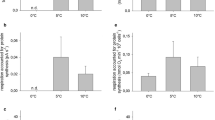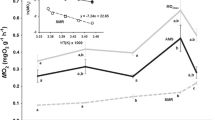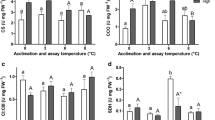Abstract
Capacities and effects of cold or warm acclimation were investigated in two zoarcid species from the North Sea (Zoarces viviparus) and the Antarctic (Pachycara brachycephalum) by investigating temperature dependent mitochondrial respiration and activities of citrate synthase (CS) and NADP+ -dependent isocitrate dehydrogenase (IDH) in the liver. Antarctic eelpout were acclimated to 5°C and 0°C (controls) for at least 10 months, whereas boreal eelpout, Z. viviparus (North Sea) were acclimated to 5°C and to 10°C (controls). Liver sizes were found to be increased in both species in the cold, with a concomitant rise in liver mitochondrial protein content. As a result, total liver state III rates were elevated in both cold-versus and warm-exposed P. brachycephalum and Z. viviparus, with the highest rates in boreal eelpout acclimated to 5°C. CS and IDH activities in the total liver were similar in Z. viviparus acclimated to 5°C and 10°C, but decreased in those warm acclimated versus control P. brachycephalum. Enzyme capacities in the total liver were higher in eelpout from Antarctica than those from the North Sea. In conclusion, cold compensation of aerobic capacities in the liver seems to be linked to an increase in organ size with unchanged specific mitochondrial protein content. Despite its life in permanently cold climate, P. brachycephalum was able to reduce liver aerobic capacities in warm climate and thus, displayed a capacity for temperature acclimation.






Similar content being viewed by others
References
Alp RP, Newshole EA, Zammit VA (1976) Activities of citrate synthetase and NAD+-linked and NADP+-linked isocitrate dehydrogenase in muscle from vertebrates and invertebrates. Biochem J 154:689–700
Anderson ME (1994) Systematics and Osteology of the Zoarcidae (Teleostei: Perciformes). Ichthyol Bull 60:120
Blier PU, Guderley H (1993) Mitochondrial activity in rainbow trout red muscle: the effect of temperature on the ADP-dependence of ATP synthesis. J Exp Biol 176:145–157
Blier PU, Lemieux H (2001) The impact of the thermal sensitivity of cytochrome c oxidase on the respiration rate of Arctic charr red muscle mitochondria. J Comp Physiol B 171:247–253
Brand MD (1990) The contribution of the leak of protons across the mitochondrial inner membrane to standard metabolic rate. J Theor Biol 145:267–286
Brand MD, Chien LF, Ainscow EK, Rolfe DFS, Porter RK (1994) The causes and functions of mitochondrial proton leak. Biochem Biophys Acta 1187:132–139
Brookes PS, Buckingham JA, Tenreiro AM, Hulbert AJ, Brand MD (1998) The proton permeability of the inner membrane of liver mitochondria from ectothermic and endothermic vertebrates and from obese rats: correlations with standard metabolic rate and phospholipid fatty acid composition. Comp Biochem Physiol B 119:325–334
Campbell C, Davies P (1978) Temperature acclimation in the teleost, Blennius pholis: changes in enzyme activity and cell structure. Comp Biochem Physiol B 61:165–167
Chance B, Williams GR (1956) The respiratory chain and oxidative phosphorylation. Adv Enzymol 17:65–134
Clarke A (1991) What is cold compensation and how should we measure it? Am Zool 31:81–92
Crockett EL, Sidell BD (1990) Some pathways of energy metabolism are cold adapted in Antarctic fishes. Physiol Zool 63:472–488
van Dijk PLM, Tesch C, Hardewig I, Pörtner HO (1999) Physiological disturbances at critically high temperatures: a comparison between stenothermal Antarctic and eurythermal temperate eelpouts (Zoarcidae). J Exp Biol 202:3611–3621
Eastman J (1993) Antarctic fish biology: evolution in a unique environment. Academic, San Diego
Egginton S, Sidell B (1989) Thermal acclimation induces adaptive changes in subcellular structure of fish skeletal muscle. Am J Physiol 256:R1–R10
Ellory JC, Hall AC (1987) Temperature effects on red cell membrane transport processes. In: Bowler K, Fuller BJ (eds.) Temperature and animal cells. Symp Soc Exp Biol 31:53–66
Fischer T (2002) The effects of climate induced temperature changes on cod (Gadus morhua L.): linking ecological and physiological investigations. PhD Thesis, University Bremen
Gonzalez-Cabrera PJ, Dowd F, Pedibhotla VK, Rosario R, Stanley-Samuelson D, Petzel D (1995) Enhanced hypo-osmoregulation induced by warm-acclimation in Antarctic fish mediated by increased gill and kidney Na+/K+ -ATPase activities. J Exp Biol 198:2279–2291
Gornall AG, Bardawill CJ, David MM (1949) Determination of serum proteins by means of biuret reaction. J Biol Chem 117:751–66
Guderley H (1998) Temperature and growth rates as modulators of the metabolic capacities of fish muscle. In: Pörtner HO, Playle R (eds.) Cold ocean physiology. Cambridge University Press, London, pp 58–87
Hardewig I, Peck LS, Pörtner HO (1999) Thermal sensitivity of mitochondrial function in the Antarctic Notothenioid Lepidonotothen nudifrons. J Comp Physiol B 169:597–604
Johnston IA, Guderley H, Franklin CE, Crockford T, Kamunde C (1994) Are mitochondria subject to evolutionary temperature adaptations?. J Exp Biol 195:293–306
Johnston IA, Calvo J, Guderley H, Fernandez D, Palmer L (1998) Latitudinal variation in the abundance and oxidative capacities of muscle mitochondria in perciform fishes. J Exp Biol 201:1–12
Kawall HG, Torres JJ, Sidell BD, Somero GN (2002) Metabolic cold adaptation in Antarctic fishes: evidence from enzymatic activities of brain. Mar Biol 140:279–286
Kent J, Koban M, Prosser C (1988) Cold-acclimation induced protein hypertrophy in channel catfish and green sunfish. J Comp Physiol B 158:185–198
Lannig G, Eckerle LG, Serendero I, Sartoris FJ, Fischer T, Knust R, Johansen T, Pörtner HO (2003) Temperature adaptation in eurythermal cod (Gadus morhua): a comparison of mitochondrial enzyme capacities in boreal and Arctic populations. Mar Biol 142:589–599
Londraville R, Sidell B (1990) Ultrastructure of aerobic muscle in Antarctic fishes may contribute to maintenance of diffusion fluxes. J Exp Biol 150:205–220
Lucassen M, Schmidt A, Eckerle LG, Pörtner HO (2003) Mitochondrial proliferation in the permanent versus temporary cold: enzyme activities and mRNA levels in Antarctic and temperate zoarcid fish. Am J Physiol Regul Integr Comp Physiol 258:1410–1420
Mark FC, Bock C, Pörtner HO (2002) Oxygen-limited thermal tolerance in Antarctic fish investigated by MRI and 31P-MRS. Am J Physiol 283(5):R1254–R1262
Moyes CD, Buck LT, Hochachka PW (1988) Temperature effects on pH of mitochondria isolated from carp red muscle. Am J Physiol 254(4):R611–R615
Peck LS (1989) Temperature and basal metabolism of two Antarctic marine herbivores. J Exp Mar Biol Ecol 125:1–12
Peck LS (2002) Ecophysiology of Antarctic marine ectotherms: limits to life. Polar Biol 25:31–40
Pelletier D, Guderley H, Dutil JD (1993) Does the aerobic capacity of fish muscle change with growth rates? Fish Physiol Biochem 12:83–93
Pörtner HO (2001) Climate change and temperature dependent biogeography: oxygen limitation of thermal tolerance in animals. Naturwissenschaften 88:137–146
Pörtner HO (2002a) Climate variations and the physiological basis of temperature dependent biogeography: systemic to molecular hierarchy of thermal tolerance in animals. Comp Biochem Physiol A 132:739–761
Pörtner HO (2002b) Physiological basis of temperature dependent biogeography: trade-offs in muscle design and performance in polar ectotherms. J Exp Biol 205:2217–2230
Pörtner HO, Peck LS, Zielinski S, Conway LZ (1999a) Intracellular pH and energy metabolism in the highly stenothermal Antarctic bivalve Limopsis marionensis as a function of ambient temperature. Polar Biol 22:17–30
Pörtner HO, Hardewig I, Peck LS (1999b) Mitochondrial function and critical temperature in the Antarctic bivalve, Laternula elliptica. Comp Biochem Physiol A 124:179–189
Pörtner HO, van Dijk PLM, Hardewig I, Sommer A (2000) Levels of metabolic cold adaptation: tradeoffs in eurythermal and stenothermal ectotherms. In: Davison W, Williams CH (eds.) Antarctic ecosystems: models for wider ecological understanding. Caxton Press, Christchurch, pp 109–122
Sazanov LA, Jackson JB (1994) Proton-translocating transhydrogenase and NAD- and NADP-linked isocitrate dehydrogenases operate in a substrate cycle which contributes to fine regulation of the tricarboxylic acid cycle activity in mitochondria. FEBS Lett. 344:109–116
Seddon W, Prosser C (1997) Seasonal variations in the temperature acclimation response of the channel catfish, Ictalurus punctatus. Physiol Zool 70:33–44
Sidell W, Driedzic WR, Stowe DB, Johnston IA (1987) Biomedical correlations of power development and metabolic fuel preferenda in fish hearts. Physiol Zool 60:221–232
Sokolova IM, Pörtner HO (2001) Temperature effects on key metabolic enzymes in Littorina saxatilis and L. obtusata from different latitudes and shore levels. Mar Biol 139:113–126
Somero GN, de Vries AL (1967) Temperature tolerance of some Antarctic fishes. Science 156:257–258
Sommer AM, Pörtner HO (2002) Metabolic cold adaptation in the lugworm Arenicola marina (L.): comparison of White Sea and a North Sea population. Mar Ecol Prog Ser 240:171–182
van den Thillart G, Modderkolk J (1978) The effect of acclimation temperature on the activation energies of state III respiration and on the unsaturation of membrane lipids of goldfish mitochondria. Biochem Biophys Acta 510:38–51
Torres J, Somero G (1988) Metabolism, enzymic activities and cold adaptation in Antarctic mesopelagic fishes. Mar Biol 98:169–180
Weinstein RB, Somero GN (1998) Effects of temperature on mitochondrial function in the Antarctic fish Trematomus bernachii. J Comp Physiol 168:190–196
Acknowledgements
The authors would like to thank M. Lucassen for assistance in developing the stabilisation buffer for analysis of NADP+ -dependent isocitrate dehydrogenase activity, T. Hirse for support in protein determinations, and E. Brodte for her helpful comments on the manuscript.
Author information
Authors and Affiliations
Corresponding author
Rights and permissions
About this article
Cite this article
Lannig, G., Storch, D. & Pörtner, HO. Aerobic mitochondrial capacities in Antarctic and temperate eelpout (Zoarcidae) subjected to warm versus cold acclimation. Polar Biol 28, 575–584 (2005). https://doi.org/10.1007/s00300-005-0730-9
Received:
Revised:
Accepted:
Published:
Issue Date:
DOI: https://doi.org/10.1007/s00300-005-0730-9




